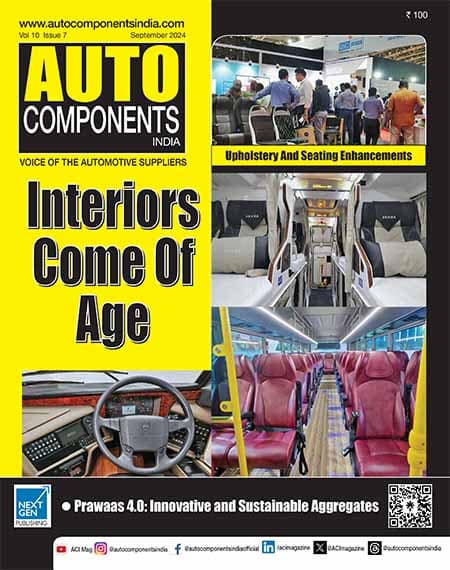In an Upfront and exclusive interaction, Jerome Mortal, Director of New Mobilities at Valeo shares the strategic focus areas for new ‘zero-emissions’ mobility solutions with Team ACI.
Q. What was the strategy behind adapting the 48V motor to e-bikes? Is it a first for the segment?
A. One of our key strategic focuses is accelerating our expansion in the emerging markets for new “zero-emissions” mobility. This includes electric small city vehicles, electric motorcycles and scooters, last-mile autonomous delivery droids and e-bikes. To execute this, we are leveraging and adapting the technological platforms that we developed for the automotive industry – both, those dedicated to Advanced Driver Assistance Systems (ADAS) and to low-voltage electrification (48V).
Thanks to our 48V technological platform, which enables us to electrify vehicles at an optimal cost, we can meet a broad range of needs and uses from a single technology base and therefore benefit from substantial volume effects and economies of scale. Our 48V technologies equip cars of course, but can also be used in autonomous shuttles, delivery droids, scooters, three-wheelers and now e-bikes.
Q. What is the e-bike market size by production volumes and sales?
A. The e-bike market is booming, with a 15-fold expansion expected over the next ten years, bringing global sales to Euro 270 million in 2030 as per a McKinsey/Center For Future Mobility -2020 study. With this innovation for e-bikes, Valeo once again demonstrates its role as a major player in e-mobility in all its forms; proposing a system that already meets the most demanding automotive standards in terms of quality, robustness, durability and safety. We are a world leader in vehicle electrification. Imagine that! One out of three new cars in the world are equipped with our electric machines! We have a unique capacity to produce electric systems on a large scale, with an estimated 30 million electric machines produced annually.
Q. How advanced is the electric assistance system?
A. Quite simply, it’s the most high-performance electric assistance technology on the market. Compared with the current systems, it’s 60 per cent more powerful! With a torque of 130 Nm, the driving assistance can multiply the pedal torque eight-fold, while other systems on the market offer up to a five-fold boost, allowing the cyclist to ride comfortably and effortlessly in every situation. Valeo’s electric motor is more efficient than the 24V or 36V motors installed on the vast majority of e-bikes available today. It can fit to all types of e-bikes: city bike, trekking bike, cargo bike.
Q. How did you achieve the integration of both the electric motor and the adaptive automatic transmission in the pedal assembly?
A. With our innovation, we bring the same kind of functionality as in the automotive world, where modern automatic gearboxes are radically changing the driving experience for users. We have aimed for the same principle of intelligence for the bicycle with a system that can be used either in fully automatic or manual mode. Our system can analyse the cyclist’s performance and dynamics to adapt the assistance to his or her abilities or the way he or she pedals. In short, it is an intelligent system. And it’s all in one package. Valeo’s added value comes from its automotive know-how and all its other recent electrical developments. We have formed a complementary alliance with the French company Effigear, a specialist in bicycle gearboxes. This association has given rise to an innovation that has no equivalent in the world
of bicycles.
Q. How does the bike adapt to the cyclist instead of vice versa?
A. With its adaptive automatic transmission, the world’s first for e-bikes, our technology uses a finely-tuned algorithm to adapt to each person’s riding style and comfort zone. The gears shift instantly and seamlessly depending on how flat or steep the route is, without the cyclist’s input. Valeo’s entire expertise in terms of adaptive automatic transmissions for cars can now be integrated into bikes.
Q. How did you get the tier suppliers to align?
A. We are partnering with Effigear on adaptive transmissions, which change gears automatically and instantly adjust the level of electrical assistance to the rider’s needs. We have an Effigear license for the gear change mechanism. The Effigear solution is already well established and has allowed us to move much faster in designing our solution. The partnership forms part of our open innovation strategy: we never shy away from collaborating with other stakeholders – universities, start-ups, manufacturers, etc. Doing so helps us design and bring products to market more quickly.
Q. How did you plan a cargo variant? And are the specs higher to cater to the segment’s load-carrying requirements? For example, the push assist function and the boost?
A. On cargo bikes you will find the ‘walk’ mode in forward and reverse. This allows you to walk next to the bike, especially when it is loaded, with an electric motion aid. Cargo bikes will also have a freewheel battery recharge. The intelligent function is based on measuring the cadence, the power applied to the pedals and the bike’s attitude. The algorithm optimises the power to be developed and engages the right gears according to all these parameters. The integrated gearbox also offers the possibility to shift gears when stationary. We also offer exceptional anti-theft functionality thanks to the integrated gearbox. When stopped, the bike is neutralised with the gearbox in neutral. And when you reach the end of the battery capacity, the system switches to second gear, which allows you to return home without stress.
Q. How would you rate the efficiency and power of the electric assistance system?
The efficiency and the power of our technology is particularly adapted to cargo bikes for deliveries, for which the market is also set to grow substantially as regulations prohibiting access to city centers for polluting vehicles gradually come into force. A cargo bike equipped with Valeo’s high-end electric assistance system allows the cyclist to climb or reverse up a parking garage ramp with little muscular effort while carrying a 150 kg load. It also boasts a pedestrian push-assist function, in both forward and reverse mode, which is particularly useful when carrying heavy loads. The boost function makes it easier to overtake other cyclists and climb hills. On a cargo bike, Valeo’s solution also features a unique braking energy recovery function.
Q. A word on the elimination of vulnerable bike parts while working on the system from scratch? We hear the count is close to 50.
A. Starting from a blank page rather than from the bike as it exists, we completely redesigned the bike of tomorrow, thanks to our technology. In practical terms, that means no more derailleurs, sprockets or handlebar gear shifts – or any of the cables that come with them – and no more chains as we know them – they’re replaced by a much more solid and reliable belt system. All in all, electric bikes are freed of around 50 fragile parts that require constant maintenance. On average, a traditional model needs to be serviced at least once a month, even if it’s just to tighten the chain, lubricate the chain and/or derailleurs, or put the chain back in place. With our technology, it’s over!
Q. How significant is the contribution to the emerging market potential of ‘zero-emissions’ mobility?
A. Developing technologies that promote greener mobility is part of our DNA. Ten years ago, Jacques Aschenbroich announced that, “Over the next decade, our growth driver will be the reduction of CO2 emissions.” Over the past 10 years, Valeo has invested more than Euro 10 billion in technologies aimed at reducing CO2 emissions. Thanks to this vision and these capital outlays, Valeo has become the world leader in automotive electrification, both in low-voltage solutions and in high-voltage solutions, through its Valeo-Siemens joint venture. We currently have an absolutely unique portfolio of technologies covering every segment
and all uses.
Naturally, our technologies directly reduce CO2 emissions from automobiles, but now they are becoming more impactful as they can be fitted on all new forms of electric mobility, especially those set to see rapid expansion in towns and cities. By 2030, 100 per cent of kick scooters will be electric, as will 65 per cent of bikes, 95 per cent of two-wheel scooters and 95 per cent of three-wheelers. Our technologies are even capable of injecting unused electricity back into city power grids. Thanks to Valeo technologies, cars will become an integral part of a city’s power grid. Last year, 57 per cent of our sales were generated by technologies aimed at reducing CO2 emissions.
Q. How are you combating growing protectionism and the call for higher localisation?
A. We will eventually set up production lines based on where our bike manufacturer customers are building their bikes. This is one of the strengths of a group like Valeo, which has a worldwide manufacturing footprint. ACI














